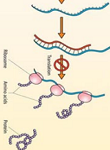|
|
|
RNA therapeutics: RNAi and antisense mechanisms and clinical applications
|
|
|
|
|
|
|
|
|
|

|
|
|
|
Jessica Chery.
|
|
|
|
Harvard Medical School/MGH
|
|
Department of Cell Biology, Massachusetts General Hospital Cancer Center, Boston, MA 02129
|
|
jchery3@mgh.harvard.edu
|
|
|
|
|
|
|
|
|
|

|
|
RNA therapeutics refers to the use of oligonucleotides to target primarily ribonucleic acids (RNA) for therapeutic efforts or in research studies to elucidate functions of genes. Oligonucleotides are distinct from other pharmacological modalities, such as small molecules and antibodies that target mainly proteins, due to their mechanisms of action and chemical properties. Nucleic acids come in two forms: deoxyribonucleic acids (DNA) and ribonucleic acids (RNA). Although DNA is more stable, RNA offers more structural variety ranging from messenger RNA (mRNA) that codes for protein to non-coding RNAs, microRNA (miRNA), transfer RNA (tRNA), short interfering RNAs (siRNAs), ribosomal RNA (rRNA), and long-noncoding RNAs (lncRNAs). As our understanding of the wide variety of RNAs deepens, researchers have sought to target RNA since >80% of the genome is estimated to be transcribed. These transcripts include non-coding RNAs such as miRNAs and siRNAs that function in gene regulation by playing key roles in the transfer of genetic information from DNA to protein, the final product of the central dogma in biology. Currently there are.....
|
|
|
|
|
|
|
|

|
|